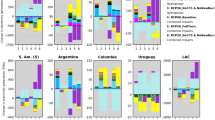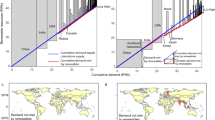Abstract
The development of new electricity generation capacity is constrained by water resource availability. However, the sufficiency of available water resources is rarely incorporated into the planning of electricity capacity expansion in the United States. Previous studies on the implications of water constraints on US electricity generation are limited in terms of scale and robustness. Here, we extend previous studies by including physical water constraints within a state-level model of the US energy system embedded within a global integrated assessment model (GCAM-USA) that integrates both supply and demand effects under a consistent framework. We show that water constraints have two general effects across the United States: (1) to increase the cost of electricity generation, which results in slightly reduced electrification of end-use sectors, and (2) to incentivize early retirement of water-intensive technologies before the end of their designed lifetimes, while simultaneously boosting investment in less water-dependent technologies. Our results suggest that water availability constraints may cause substantial capital stock turnover and result in non-negligible economic costs for the western United States, whereas fewer impacts may be anticipated in the eastern United States. Our work emphasizes the need to integrate water availability constraints into electricity capacity planning and highlights the state-level challenges to facilitate regional strategic resource planning.
This is a preview of subscription content, access via your institution
Access options
Access Nature and 54 other Nature Portfolio journals
Get Nature+, our best-value online-access subscription
$29.99 / 30 days
cancel any time
Subscribe to this journal
Receive 12 digital issues and online access to articles
$119.00 per year
only $9.92 per issue
Buy this article
- Purchase on Springer Link
- Instant access to full article PDF
Prices may be subject to local taxes which are calculated during checkout






Similar content being viewed by others
Data availability
The data that supports the findings of this study is available from the corresponding author on request.
References
Renewable Energy Action Team. Best Management Practices and Guidance Manual: Desert Renewable Energy Projects REAT‐1000‐2010‐009 (California Energy Commission, Siting, Transmission and Environmental Protection Division, 2010).
Governor Brown Directs First Ever Statewide Mandatory Water Reductions (Office of Governor Edmund G. Brown Jr, 2015); https://www.ca.gov/archive/gov39/wp-content/uploads/2017/09/4.1.15_Executive_Order.pdf
Rangel, L. Austin will Stay under Stage 2 Water Restrictions Indefinitely (KXAN, 2016); http://kxan.com/2016/05/05/council-votes-to-keep-austinites-under-stage-2-water-restrictions-indefinitely/
House Bill No. 791 (Idaho, 2006).
Averyt, K. et al. Freshwater Use by US Power Plants: Electricity’s Thirst for a Precious Resource (Union of Concerned Scientists, 2011).
Rogers, J. et al. Water-Smart Power: Strengthening the US Electricity System in a Warming World (Union of Concerned Scientists, 2013).
Macknick, J. et al. Water Constraints in an Electric Sector Capacity Expansion Model (National Renewable energy Laboratory, 2015).
Morlock, B. ACC Nixes Generation Station near Eloy. Tucson Citizen (31 January 2002).
Power plant shelved after water use denied. Seattle Post-Intelligencer (2002); http://www.seattlepi.com/news/article/Power-plant-shelved-after-water-use-denied-1092708.php
Stineman, D. Energy project could threaten water supply in Salina, Kansas. The Salina Journal (14 November 2006).
Rose, C. D. Sempra abandons bid to build 2 coal-fired electric plants. U-T San Diego (30 March 2006); http://legacy.sandiegouniontribune.com/uniontrib/20060330/news_1b30sempra.html
Iyer, G. et al. Measuring progress from nationally determined contributions to mid-century strategies. Nat. Clim. Change 7, 871–874 (2017).
Iyer, G. et al. GCAM-USA Analysis of US Electric Power Sector Transitions (US Department of Energy, 2017).
Webster, M., Donohoo, P. & Palmintier, B. Water–CO2 trade-offs in electricity generation planning. Nat. Clim. Change 3, 1029–1032 (2013).
Tidwell, V., Bailey, M., Zemlick, K. & Moreland, B. Water supply as a constraint on transmission expansion planning in the Western interconnection. Environ. Res. Lett. 11, 124001 (2016).
Maupin, M. A. et al. Estimated Use of Water in the United States in 2010. Circular 1405 (US Geological Survey, 2010).
Liu, L. et al. Water demands for electricity generation in the US: Modeling different scenarios for the water–energy nexus. Technol. Forecast. Soc. Change 94, 318–334 (2015).
US State Profiles and Energy Estimates (Energy Information Administration, 2017); www.eia.gov/states/
Standards of Performance for Greenhouse Gas Emissions from New, Modified, and Reconstructed Stationary Sources: Electric Utility Generating Units (Environmental Protection Agency, 2015); https://regulations.justia.com/regulations/fedreg/2015/10/23/2015-22837.html/
Macknick, J., Newmark, R., Heath, G. & Hallett, K. C. Operational water consumption and withdrawal factors for electricity generating technologies: a review of existing literature. Environ. Res. Lett. 7, 045802 (2012).
Clarke, J. F. & Edmonds, J. A. Modelling energy technologies in a competitive market. Energy Econ. 15, 123–129 (1993).
Liu, L., Hejazi, M., Li, H., Forman, B. & Zhang, X. Vulnerability of US thermoelectric power generation to climate change when incorporating state-level environmental regulations. Nat. Energy 2, 17109 (2017).
Davies, E. G. R., Kyle, P. & Edmonds, J. A. An integrated assessment of global and regional water demands for electricity generation to 2095. Adv. Water Resour. 52, 296–313 (2013).
United States Mid-Century Strategy for Deep Decarbonization (The White House, 2016).
IPCC Climate Change 2014: Mitigation of Climate Change (eds Edenhofer, O. et al.) (Cambridge Univ. Press, 2014).
Rosen, R. A. & Guenther, E. The economics of mitigating climate change: what can we know? Technol. Forecast. Soc. Change 91, 93–106 (2015).
Brenkert, M., Smith, S. J., Kim, S. & Pitcher, H. Model Documentation for the MiniCAM PNNL Report-14337 (Pacific Northwest National Laboratory, 2003).
Clarke, L. et al. Model Documentation for the MiniCAM Climate Change Science Program Stabilization Scenarios PNNL Report-16735 (Pacific Northwest National Laboratory, 2007).
Edmonds, J. & Reilly, J. M. Global Energy: Assessing the Future (Oxford Univ. Press, 1985).
Kim, S. H., Edmonds, J., Lurz, J., Smith, S. J. & Wise, M. The objECTS framework for integrated assessment: Hybrid modeling of transportation. Energy J. 0(Special I), 63–92 (2006).
Zhou, Y. et al. Modeling the effect of climate change on US state-level buildings energy demands in an integrated assessment framework. Appl. Energy 113, 1077–1088 (2014).
EW3 Energy–Water Database v.1.3 (UCS, 2012); http://www.ucsusa.org/clean-energy/energy-water-use/ucs-power-plant-database#
Tidwell, V. C. et al. Mapping water availability, projected use and cost in the western United States. Environ. Res. Lett. 9, 064009 (2014).
Tidwell, V. C., Moreland, B. D., Shaneyfelt, C. R. & Kobos, P. Mapping water availability, cost and projected consumptive use in the eastern United States with comparisons to the west. Environ. Res. Lett. 13, 014023 (2018).
Acknowledgements
This research was supported by the Office of Science of the US Department of Energy through the Integrated Assessment Research Program. PNNL is operated for DOE by Battelle Memorial Institute under contract DE-AC05-76RL01830. We would also like to acknowledge V. Tidwell for providing water availability data for the United States.
Author information
Authors and Affiliations
Contributions
L.L, M.H. and G.I. designed the study. L.L performed all analyses and worked with G.I. in configuring the model. B.F., M.H. and G.I. worked on revising the manuscript. All authors contributed to the discussion of the results.
Corresponding author
Ethics declarations
Competing interests
The authors declare no competing interests.
Additional information
Publisher’s note: Springer Nature remains neutral with regard to jurisdictional claims in published maps and institutional affiliations.
Supplementary information
Supplementary Information
Supplementary Figures 1–9, Supplementary Tables 1–2, Supplementary Notes 1–4, Supplementary References 1–11
Rights and permissions
About this article
Cite this article
Liu, L., Hejazi, M., Iyer, G. et al. Implications of water constraints on electricity capacity expansion in the United States. Nat Sustain 2, 206–213 (2019). https://doi.org/10.1038/s41893-019-0235-0
Received:
Accepted:
Published:
Issue Date:
DOI: https://doi.org/10.1038/s41893-019-0235-0
This article is cited by
-
The global power sector’s low-carbon transition may enhance sustainable development goal achievement
Nature Communications (2023)
-
Unintended consequences of climate change mitigation for African river basins
Nature Climate Change (2022)
-
Agricultural impacts of sustainable water use in the United States
Scientific Reports (2021)
-
Air pollution control strategies directly limiting national health damages in the US
Nature Communications (2020)
-
Hydrological limits to carbon capture and storage
Nature Sustainability (2020)



